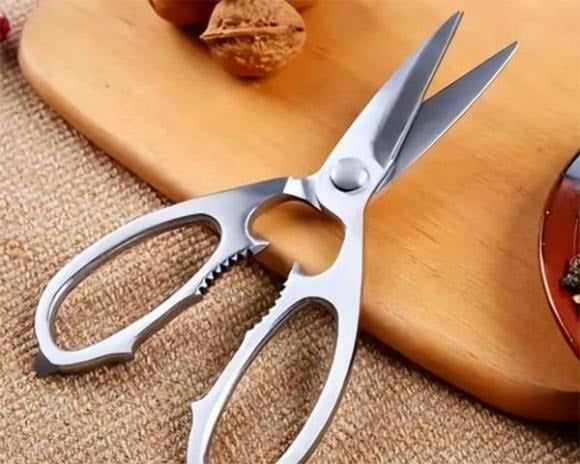The Evolution of Scissors Through the Ages
The Bronze Age marked pivotal moments in the development of scissors, as advancements in metallurgy led to significant changes in material quality and scissor-making processes.
The earliest bronze scissors appeared in China during the Western Han Dynasty, attributed to the legendary master Lu Ban. He is said to have used his extraordinary wisdom to invent the unique “cross-bottom” scissors.
While these scissors offered far superior cutting abilities compared to Stone Age tools, they had limitations, such as a small opening that restricted their use for heavy-duty or hard material cutting. Nonetheless, their emergence marked a significant step forward in humanity’s tool-making history.
The Tang Dynasty, one of the most prosperous periods in Chinese history, witnessed a remarkable evolution in scissor manufacturing. Scissors from this era stood out not only for their practicality but also for their artistic value. Artisans skillfully engraved and even inlaid them with jewelry, transforming these tools into exquisite and functional works of art.

The earliest bronze scissors, invented by the legendary master Lu Ban during the Western Han Dynasty in China.
These intricate scissors served not just as cutting tools but also as status symbols and emblems of identity. The nobility and officials avidly collected these scissors as prized possessions.
Additionally, scissors held profound cultural significance. People believed that scissors could ward off evil spirits, so they often hung them above doorways to protect their homes.
Tang Dynasty scissors reflected not only the exceptional talent of artisans but also the prosperity and cultural diversity of society at the time.
Scissors evolved from a simple tool into a cultural icon, carrying hopes for a better life and respect for the unknown.
The Birth of Modern Scissors
As society progressed, so did the need for scissors evolve. The limitations of “cross-bladed” scissors became increasingly apparent, and people required a more flexible and efficient cutting tool.
During the Northern Song Dynasty, a talented craftsman had a creative insight and invented the “pillar-style” scissors. This type of scissors cleverly applied the principle of leverage, with the blades connected via pivots and the handles designed as double rings.
These new scissors not only provided more powerful cutting capabilities but also offered greater flexibility and convenience. They could cut harder materials and perform tasks requiring high precision. This invention marked the beginning of a new era for scissors, laying the foundation for future scissor designs.
Optimal Scissor Placement
With scissors being commonly used in daily life, proper placement has become a matter of concern. An old saying goes, “Placing scissors in three places brings hardship to the household,” offering wisdom based on long-standing experience. So, what are the three places to avoid when it comes to scissor placement?
The living room, considered the face of the home and the primary gathering space for families, is not ideal for scissor placement. Keeping scissors here not only creates an uneasy and unsafe atmosphere but also poses potential dangers, especially for families with young children who might be curious and at risk of injury.
The bedroom, meant for rest and relaxation, demands a peaceful and comfortable environment. Placing scissors at the bedside disrupts the harmony of the space and may affect sleep quality. Psychologically, having scissors at the bedside can induce anxiety and worry, especially for sensitive individuals, leading to noticeable negative impacts.
The balcony, a space that invites fresh air and is often used for gardening, is also not suitable for careless scissor placement. While scissors are essential for gardening, leaving them unattended on the balcony can create safety hazards, especially in spacious or windy areas, as they may be blown away and cause unnecessary trouble.
So, Where Should Scissors Be Placed?
Kitchen cabinets or storage baskets are excellent choices, providing easy access while maintaining safety. A separate tool box dedicated to storing scissors and other utensils is also a safe and convenient solution.
For special spaces like craft rooms or studios, where scissors are frequently used, opt for safety-lock scissors. These scissors can lock the blades when not in use, minimizing the risk of injury.

Kitchen cabinets or storage baskets are ideal for scissor placement, offering both convenience and safety.
Conclusion:
The proverb, “Placing scissors in three places brings hardship to the household,” showcases a meticulous attention to detail in life and underscores the importance of ensuring safety.
In modern society, while we may not be superstitious, it is wise to heed the wisdom embedded in these teachings. Proper scissor placement is not just about safety but also demonstrates our respect and care for our well-being.
Don’t Add MSG to Your Food Using These 5 Methods: A Health Hazard!
Monosodium Glutamate, or MSG as it is commonly known, is a popular flavor enhancer used in cooking around the world. However, there are certain dishes where MSG should be avoided for a variety of reasons. Stay tuned as Bach Hoa XANH takes us on a journey to uncover why this common seasoning should be left out of some of our favorite recipes.
The Sweet Significance of Wedding Cakes: A Guide to Elegant and Delicious Designs
In this article, we delve into the significance of the wedding cake and offer a curated selection of exquisite designs to inspire your own celebration. We’ll explore the traditional symbolism of this iconic centerpiece and present a gallery of elegant cakes that are sure to leave a lasting impression. Join us as we uncover the secrets behind this beloved wedding tradition and provide you with the inspiration to create your own unforgettable masterpiece.






































